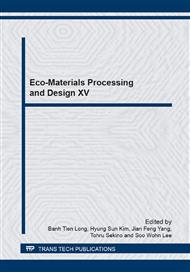p.3
p.7
p.11
p.15
p.19
p.23
p.27
p.31
p.35
Fabrication of FRP Spacers of Insulating Glass for Energy-Saving Eco-Friendly Home
Abstract:
The FRP(fiber reinforced plastics) spacer was fabricated to enhance the heat blocking and mechanical properties of insulating glass for energy-saving eco-friendly home. The fiber volume percent in ABS(acrylonitrile-butadiene-styrene) matrix was chosen as a main controlling factor. The various properties of FRP spaces were evaluated such as 3-point bending strength, thermal conductivity, and water absorption rate. And the aging test was performed at various temperatures for the spacer immersed in water. In conclusion, the optimum fiber volume percent, 25wt% of spacer was found that is enough for handling in construction process and appropriate for blocking the heat loss through the insulating glass window.
Info:
Periodical:
Pages:
19-22
Citation:
Online since:
October 2014
Authors:
Keywords:
Price:
Сopyright:
© 2015 Trans Tech Publications Ltd. All Rights Reserved
Share:
Citation:


